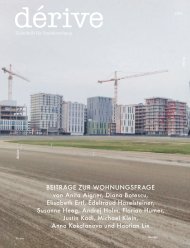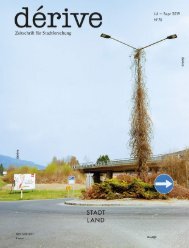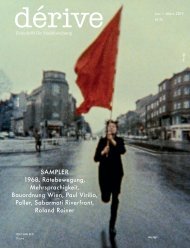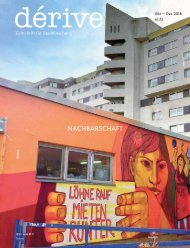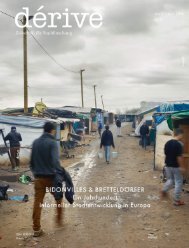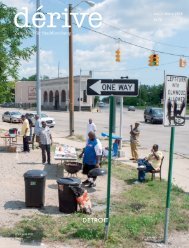Warsaw: Devastation, Modernization, (Re-)privatization, dérive - Zeitschrift für Stadtforschung, Heft 72 (3/2018)
Warsaw is a city that has experienced radical breaks in its development over the last century, which are still relevant and visible in many different ways today. There is the Nazi occupation, the crushing of the Warsaw Ghetto Uprising and the subsequent systematic and almost complete destruction of the city; and more recently, the shift from a state-socialist to capitalist system. The new issue of dérive, entitled »Warsaw: Devastation, Modernization, (Re-)privatization«, sheds light both on these historical components and their impact on contemporary urban society – e.g. on the housing market. In addition, we talk to people who are self-organizing and working on alternative solutions that resist current socio-political conditions. The focal point is entirely in English. You can order it here: https://shop.derive.at/collections/einzelpublikationen/products/heft-72
Warsaw is a city that has experienced radical breaks in its development over the last century, which are still relevant and visible in many different ways today. There is the Nazi occupation, the crushing of the Warsaw Ghetto Uprising and the subsequent systematic and almost complete destruction of the city; and more recently, the shift from a state-socialist to capitalist system. The new issue of dérive, entitled »Warsaw: Devastation, Modernization, (Re-)privatization«, sheds light both on these historical components and their impact on contemporary urban society – e.g. on the housing market. In addition, we talk to people who are self-organizing and working on alternative solutions that resist current socio-political conditions. The focal point is entirely in English. You can order it here: https://shop.derive.at/collections/einzelpublikationen/products/heft-72
You also want an ePaper? Increase the reach of your titles
YUMPU automatically turns print PDFs into web optimized ePapers that Google loves.
one of the most famous music bands from <strong>Warsaw</strong> is the<br />
<strong>Warsaw</strong> Village Band. Yet, there is an order behind what seems<br />
like a random patchwork. In her essay reprinted in this issue<br />
of <strong>dérive</strong>, Joanna Kusiak shows how <strong>Warsaw</strong>’s urban fabric –<br />
elusive and nonintuitive at first glance – represents a palimpsest<br />
of many attempts to break with history. In this sense, <strong>Warsaw</strong><br />
is a city that continuously starts anew.<br />
<strong>Warsaw</strong> is a city that continuously starts anew<br />
While the sense of looming history is indisputable and<br />
visible in the omnipresent fingerprints of the past, the city’s chaotic<br />
geography has become the fulcrum of possibility and<br />
change. As a consequence, one of the most quintessentially Warsavian<br />
debates has been on <strong>Warsaw</strong>’s actual geographical location.<br />
The three essays we reprint here as <strong>Re</strong>troactive Manifestos<br />
attest to the eerie sense of ambiguity as to where <strong>Warsaw</strong> actually<br />
is. In their Warszawa Funkcjonalna research manifesto from<br />
1934, Szymon Syrkus and Jan Chmielewski start their analysis<br />
from a bird’s-eye perspective, looking at the larger international<br />
flows and networks in which <strong>Warsaw</strong> is enmeshed. Their text<br />
comprises a number of consecutive analytical steps, which are<br />
also visually represented in the corresponding maps. We reprint<br />
only the first eight of those steps, but the final outcome – the<br />
Warszawa Funkcjonalna diagram – is the cartographic theory of<br />
what constitutes, to borrow David Harvey’s phrase, the »structured<br />
urban coherence« of <strong>Warsaw</strong>.<br />
Just ten years after Warszawa Funkcjonalna was published,<br />
<strong>Warsaw</strong> was destroyed and a new city erected in its place.<br />
Yet a comparison of a map of contemporary <strong>Warsaw</strong> with the<br />
Warszawa Funkcjonalna diagram shows that the city actually did<br />
grow according to the logic Syrkus and Chmielewski had predicted.<br />
The most traumatic of events – the <strong>Warsaw</strong> Uprising and<br />
the Nazis’ destruction of the city – did little in the way of altering<br />
<strong>Warsaw</strong>’s innate trajectory. The other two manifestos –<br />
excerpts from the 1951 book entitled The Six-year Plan for<br />
<strong>Warsaw</strong>’s <strong>Re</strong>construction and an essay by Bohdan Jałowiecki –<br />
also pose the geographical question. Jałowiecki, in a gesture<br />
that generated a heated debate back in 2006, argues that <strong>Warsaw</strong><br />
is not becoming a dead ringer for a Western city but instead<br />
belongs to the family of cities from the Global South. These<br />
texts are separated by long decades and each is dedicated to a<br />
very different <strong>Warsaw</strong>. But if there is anything they have in<br />
common, then it is the sense of <strong>Warsaw</strong> being somehow out of<br />
step in terms of its geography, its actual location in the world<br />
at large.<br />
This geographical ambiguity is a source of discontents<br />
for inhabitants (and perhaps the reason why <strong>Warsaw</strong> does not<br />
have a clear-cut identity) but represents a great opportunity for<br />
urban researchers. This is why the current issue of <strong>dérive</strong> coincides<br />
with the 28th annual conference of the International Network<br />
for Urban <strong>Re</strong>search and Action (INURA). The conference<br />
will be a week-long encounter between international and local<br />
urban scholars and activists, who will – together – try to think<br />
about <strong>Warsaw</strong>’ structured coherence and answer the question of<br />
what makes it unique as a city.<br />
Because of <strong>Warsaw</strong>’s reluctance to embrace an explicit<br />
urban self-identity, it has often been spoken about as a site<br />
where other, non-urban, processes unfold – such as a putative<br />
transition from state socialism to market capitalism. But what<br />
does labelling <strong>Warsaw</strong> a post-socialist city actually mean?<br />
Instead of defining <strong>Warsaw</strong> according to what it no longer is (a<br />
socialist city) or what, in theory, it is supposed to become (a<br />
poster child for market capitalism), we will delve into places and<br />
processes that define <strong>Warsaw</strong>’s contemporary mien. To this end,<br />
we will employ INURA’s unique conference format – talking<br />
about cities in the actual urban space and not inspecting Powerpoint<br />
slides in air-conditioned rooms.<br />
We will therefore study <strong>Warsaw</strong> from the bottom up and<br />
treat it as a theoretical clean slate. Thus, we will forget about<br />
jumbo theories and turn to elements of everyday life in <strong>Warsaw</strong>:<br />
housing, transit, labour, consumption, migration, its natures and<br />
its non-human denizens. It may turn out that, for example, the<br />
annus mirabilis of 1989 does not constitute a watershed in<br />
<strong>Warsaw</strong>’s trajectory after all. Instead, longer continuities may be<br />
at work, and more recent forces may have shaken the city to its<br />
core. On the one hand, Warszawa Funkcjonalna turned out to<br />
have been uncannily precise in defining the pattern of <strong>Warsaw</strong>’s<br />
spatial expansion, despite the dramatic intrusions that the city<br />
experienced. Conversely, Poland’s 2004 accession to the European<br />
Union ushered in flows of capital that engendered entirely<br />
new spaces as well as redefining some extant ones, substantially<br />
unsettling the city and altering its position in various networks<br />
(global, national). It may be the case that <strong>Warsaw</strong> is positioned<br />
in an entirely different place.<br />
We hope our peripatetic intellectual experiment and the<br />
encounter between local and international researchers will reinvigorate<br />
urban theory. Walking and thinking have always b<br />
een intertwined. Beginning with ancient philosophers, through<br />
Rousseau and Kierkegaard and from modernist flâneurs to<br />
urban ethnographers, many theories have originated from a surprise<br />
peripatetic discovery or a chance encounter. <strong>Re</strong>cently,<br />
there has been plenty of jumbo-sized theorising about the<br />
urbanization of our planet, and we have a plethora of microstudies<br />
either describing certain places or dissecting specific<br />
urban issues. With a few exceptions (such as Filip de Boeck’s<br />
work on Kinshasa and Hidenobu Jinnai’s work on Tokyo),<br />
we are in dire need of research that shows how various fragments<br />
are, as de Boeck put it, sutured together. When Jinnai set off to<br />
walk the streets of Tokyo in the 1980s, he probably did not<br />
expect his peregrinations to allow him to discover a planning<br />
paradigm that had never been formally expressed but in fact<br />
explains precisely how his city came about and how it works.<br />
The point of departure for Jinnai’s discovery was walking.<br />
By the same token, a novel theory that stitches contemporary<br />
<strong>Warsaw</strong> together into a coherent whole may be just<br />
around the corner. We need only make our way there.<br />
Kacper Pobłocki is Assistant Professor of Anthropology and<br />
Urban Studies at the <strong>Warsaw</strong> University. He writes about<br />
class, space and uneven development. He used to be an urban<br />
activist and led the Alliance of Urban<br />
Movements that ran in 2014 in municipal elections in eleven<br />
Polish cities. In 2017 his book Kapitalizm<br />
historia krotkiego trwania (Spatial origins of capitalism<br />
the English edition forthcoming) came out.<br />
Kacper Poblocki — WARSAW. A Taciturn City<br />
05









